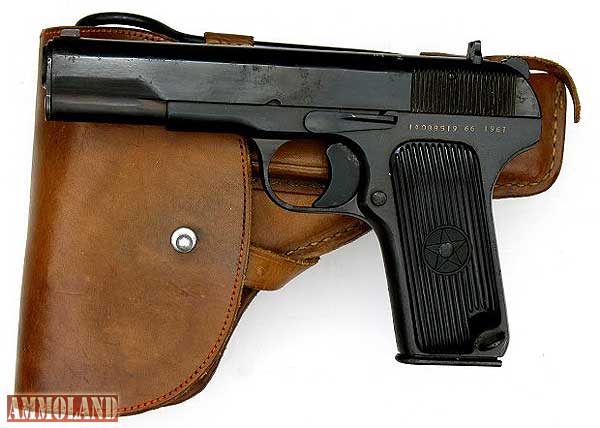TT-30 Pistol
Gun Collecting
By Peter Peter Suciu


Michigan –-(Ammoland.com)- In the 1920s, after the end of the Russian Civil War, the Soviet Union’s Red Army looked to replace the aging and obsolete Nagant M1895 revolver.
During the mid to late 1920s a number of pistols designs were considered, and the winner of the bunch of the TT-33, or Tula Tokarev, designed by Fedor Tokarev.
This firearm would become the main service pistol for the Soviet Union, and remaining in service through World War II and beyond, being adapted by numerous other nations under license. Interestingly, the Soviet’s Red Army had relied on numerous foreign handguns, notably the Mauser C96 “Broomhandle.” This weapon’s 7.63mm cartridge had proven reliable was thus popular with the gun’s users. It, along with American handgun designs, would serve as inspiration for the new Soviet firearm.

Fedor Tokarev noted the popularity of the 7.63x25mm ammo used by the C96 when he designed the TT-33, a short recoil operated, locked breech pistol. Tokarev’s design is chambered for a 7.62x25mm Tokarev cartridge, which was itself actually based on the 7.63x25mm Mauser cartridge. The handgun design further called up Browning’s swinging link system, which was “borrowed” from the Colt M1911 pistol. Externally the gun has a passing resemblance to the earlier Browning blowback operated FN Model 1903. Despite these facts it is incorrect to call the TT-33 a 1911 clone, or suggest that Tokarev merely adapted Browning’s innovations. The Tokarev design actually utilizes a much simpler hammer/sear assembly with an external hammer. However, the single action trigger features no safety, other than the disconnector to prevent out-of-battery fire, and a half-cock notch on the hammer.
Thus the only “safe” way to carry the TT was to have an empty chamber.
The TT-33 did follow standard gun design considerations of the era, and it features an 8-round detachable box magazine, and has an effective range of 50 meters, with a muzzle velocity of 420 m/s (1,378 ft/s).
Known as the TT-33, the “Tokarev” pistol actually entered service in early 1934 and was manufactured in great numbers prior to the outbreak of World War II. By the time of the Nazi invasion of the Soviet Union in June, 1941 some 600,000 TT-33s had been produced, and this number increased greatly during the so-called “Great Patriotic War.” No definitive number of Soviet made TT-33 has even been published, but it is safe to say that millions were likely made. However, production never reached the point that the aging Nagant M1895 pistol was ever fully removed from service. The need for firearms during the war was simply that great.
Following the war the pistol’s design was modified in 1946 to cut production costs, and the handgun was finally taken out of production in 1952, with the introduction of the 9mm Markarov PM pistol. Despite this fact, as with the M1895, it took time to fully replace the aging firearms, and the TT-33 remained in service with the Red Army through the 1960s, and was used by the Soviet Militia (Police) until the 1970s.
The number of TT-33 styled pistols is further increased as the gun was popular with Soviet allies in the post-war era. The handgun was produced by various Communist Bloc nations under license, and these included the China (as the Type 52, Type 54, M20 and TU-90), Poland (as the PW wz.33), North Korea (as the Type 68/M68) , Romania (as the TTC or Cugir Tokarov) and Yugoslavia (as the M57, M65, M70A).
Additionally, Yugoslavia also produced a 9x18mm version known as the M88, while Hungary rebarreled the pistol to fire 9x19mm Parabellum as the M48. The gun was also exported to Egypt (but made in the Soviet Union) and these are known as the Tokagypt 68. The gun remains in use in Pakistan with military and para-military units. This list should by no means be considered complete. Another rare variation is the World War II era Pistole 615(r). These versions were actually captured TT-33s that were reissued by the Germans (with and without German stamps), who used the handguns with the similar 7.63x25mm Mauser cartridge (we wouldn’t suggest trying that at home).
All of these variations are encountered by collectors, and those without import states, produced during the Second World War in good condition continue to fetch the best prices. Most of the imported versions feature an added trigger blocking safety however. Today, the gun remains a classic icon of the Second World War and the early Cold War, making this a firearm popular with collectors and shooters alike – thanks in part to the low cost of the 7.62x25mm ammo.

Peter Suciu is executive editor of FirearmsTruth.com, a website that tracks and monitors media bias against guns and our Second Amendment rights. Visit: FirearmsTruth.com

very accurate and reliable gun. When I worked in the police we are from him fired. At a distance of 25 meters free of three shots all three are placed in the ” top ten”.
Thjs pistol must be one of the best , throughout time